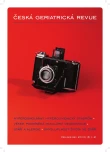Hypothyroidism in elderly
Authors:
V. Vargová; M. Pytliak; V. Mechírová
Authors‘ workplace:
III. INTERNÁ KLINIKA LF UPJŠ A FNLP, KOŠICE
1; I. INTERNÁ KLINIKA LF UPJŠ A FNLP, KOŠICE
2
Published in:
Čes Ger Rev 2010; 8(1-2): 22-26
Overview
Thyroid dysfunction occurs frequently in the elderly population, yet often goes unnoticed. Hypothyroidism is common and increases with age affecting 5–20% of women and 3–8% of men. The classical symptoms and signs of hypothyroidism may not be so obvious in the elderly, and a high degree of clinical suspicion is necessary. Elderly hypothyroid patients may have less weight gain, cold intolerance and muscle cramps, and the hypothyroidism can be easily overlooked in these patients who also have a higher prevalence of other chronic illnesses, use of medications and cognitive change than their younger counterparts. In the aged, psychiatric symptoms may dominate, with most texts on psychogeriatrics listing hypothyroidism as a cause for depression, delirium and dementia. The effects on the cardiovascular system can be a major problem and include bradycardia, hypertension, dyslipidaemia, ischaemic heart disease, and pericardial effusions. Another diagnostics problems could represents euthyroid sick syndrome, common in critically ill seniors, and subclinical hypothyroidism. Treatment of the hypothyroidism in the elderly patients should be careful and closely monitored. Whether or not to treat patients with subclinical hypothyroidism is still debated and treatment decisions should be made on an individual basis.
Key words:
hypothyroidism – elderly – euthyroid sick syndrome – subclinical hypothyroidism
Sources
1. Mokshagundam SP, Barzel US. Thyroid disease in the elderly. J Am Geriatr Soc 1993; 41: 1361–1369.
2. Mariotti S, Franceschi C, Cossarizza A et al. The aging thyroid. Endocrine Reviews 1995; 16: 686–715.
3. Kabadi UM. Thyroid disorders and the elderly. Compr Ther 1989; 15: 53–65.
4. Finucane P, Rudra T, Church H et al. Thyroid function tests in elderly patients with and without acute illness. Age Aging 1998; 18: 398–402.
5. De Grool LJ. Dangerous dogmas in medicine: The non‑thyroideal ilness syndrome. J Clin Endocrinol Metab 1999; 84 (1): 151–164.
6. Mufti TS, Jielani A. Deranged thyroid hormone status in non‑thyroid illnesses; sick euthyroid syndrome. J Ayub Med Coll Abbottabad 2006; 18 (4): 1–3.
7. Kagansky N, Tal S, Levy S. Euthyroid sick syndrome in older people. Rev Clin Gerontol 2001; 11 (1): 1–4.
8. Isley WL. Thyroid dysfunction in the severely ill and elderly: forget the clasic signs and symptoms. Postgrad Med 1993; 94 (3): 111–118.
9. Pedersen IB, Laurberg P, Knudsen N et al. An Increased Incidence of Overt Hypothyroidism after Iodine Fortification of Salt in Denmark: A Prospective Population Study. J Clin Endocrinol Metab 2007; 92 (8): 3122–3127.
10. Vanderpump MPJ, Tunbridge WMG, French JM et al. The incidence of thyroid disorders in the community: a twenty‑year follow up of the Wickham survey. Clin Endocrinol 1995; 43: 55–68.
11. Límanová Z. Oněmocnení štítné žlázy ve stáří. Čes Ger Rev 2003; 1 (3): 14–21.
12. Hak AE, Pols HA, Visser TJ et al. Subclinical hypothyroidism is an independent risk factor for atherosclerosis and myocardial infarction in eldery women: The Rotterdam Study. Ann Intern Med 2000; 132 (4): 270–278.
13. Laurberg P, Andersen S, Bülow Pedersen I et al. Hypothyroidism in the elderly: Pathophysiology, diagnosis and treatment. Drugs Aging 2005; 22 (1): 23–38.
14. Elston MS, Conaglen JV. Hypothyroism and the elderly. NZFP 2005; 32 (4): 270–274.
15. Li TM. Hypothyroidism in elderly people. Ger Nurs 2002; 232 (2): 88–93.
16. Topliss DJ, Eastman CJ. Diagnosis and management of hyper‑thyroidism and hypothyroidism. Med J Aust 2004; 180 (4): 186–193.
17. Beckett GJ, Toft AD. First‑line thyroid function tests – TSH alone is not enough. Clin Endocrinol 2003; 58 (1): 20–21.
18. Wallace K, Hoffman MT. Thyroid dysfunction: how to manage overt and subclinical disease in older patients. Geriatrics 1998; 53 (4): 32–41.
19. Sawin CT, Geller A, Hershman JM et al. The aging thyroid. The use of thyroid hormone in older persons. JAMA 1989; 261 (18): 2653–2655.
20. Hueston WJ, Pearson WS. Subclinical hypothyroidism and the risk of hypercholesterolemia. Ann Fam Med 2002; 2 (4): 351–355.
21. Gharib H, Tuttle RM, Baskin HJ et al. American Association of Clinical Endocrinologists; American Thyroid Association; The Endocrine Society Consensus Statement #1: subclinical thyroid dysfunction: a joint statement on management from the American Association of Clinical Endocrinologists, the American Thyroid Association, and the Endocrine Society. J Clin Endocrinol Metab 2005; 90: 581–585.
22. Kleiner J, Altshuler L, Hendrick V et al. Lithium‑Induced Subclinical Hypothyroidism: Review of the Literature and Guidelines for Treatment. J Clin Psychiatry 1999; 60 (4): 249–255.
23. Martino E, Bartalena L, Bogazzi F et al. The effects of amiodarone on the thyroid. Endocr Rev 2001; 22 (2): 240–254.
24. Jiskra J, Límanová Z. Amiodaron a choroby štítné žlázy. Čes Ger Rev 2003; 1 (3): 22–27.
25. Surks MI, Sievert R. Drugs and Thyroid Function. N Engl J Med 1995; 333 (25): 1688–1694.
26. Bianchi GP, Zaccheroni V, Solaroli E. Health related quality of life in patients with thyroid disorders. Qual Life Res 2004; 13 (1): 45–54.
27. Jakušová, V. Pojem kvality poskytovania zdravotníckych služieb a jej vnímanie pacientom In: Podpora zdravia, prevencia a hygiena v teórii a praxi IV. Martin: Jesseniova lekárska fakulta Univerzity Komenského 2006; 170–176.
Labels
Geriatrics General practitioner for adultsArticle was published in
Czech Geriatric Review

2010 Issue 1-2
Most read in this issue
- Hypothyroidism in elderly
- The meaningfulness of life in the elderly
- Age-related macular degeneration
- Older age and allergy – is this an issue?
